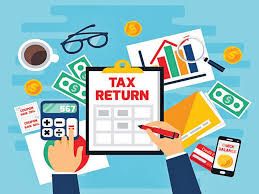Welcome to our ultimate guide on Smart Hacks for Filing ITR for FY 2024-25—where we’re not just helping you file your returns, but empowering you to file them efficiently, correctly, and maybe even with a smile.
Table of Contents
It’s that time of the year again—when words like Form 16, deductions, capital gains, and exemptions start echoing in every salaried professional’s head. Whether you’re a first-time taxpayer, a seasoned entrepreneur, or a freelancer juggling multiple income sources, filing your Income Tax Return (ITR) for Financial Year 2024–2025 can feel like walking through a maze. But what if we told you that filing your ITR doesn’t have to be stressful, confusing, or time-consuming?
The Government of India has continuously upgraded its online platforms, refined income tax rules, and introduced pre-filled data to make compliance smoother. But there’s still a catch—filing your ITR wrong can cost you more than just money. It can invite scrutiny, penalties, or missed refunds. That’s why being aware of the little things—those smart hacks and expert insights—can go a long way.
From choosing the right ITR form, to making the most of available deductions under Sections 80C, 80D, and 24(b), to avoiding the most common mistakes that delay refunds, this blog is packed with practical hacks to simplify the process. We’ll also cover new updates for FY 2024–25, changes in tax slabs (if any), how to reconcile AIS/TIS with Form 26AS, and even how to maximize refunds while staying 100% compliant.
And guess what? You don’t need to be a tax expert to crack this. Whether you’re filing on the new tax regime or sticking to the old, these hacks are designed to work for everyone—from salaried individuals and gig workers to business owners and NRIs.
So, before you rush to upload your return, take a deep breath, grab your documents, and read on. Filing ITR isn’t just a yearly formality—it’s an opportunity to take charge of your money. Let’s make it count.
One is liable to file ITR even if no tax dues:
Once you start earning, being a responsible citizen, one must file their Income-tax return.
Generally, a taxpayer believes that he isn’t liable to file a tax return since there is no tax liability pending during the financial year. It should be kept in mind that ITR has to be filed irrespective of the fact whether the tax is required to be paid or not. Generally, in case of individuals what triggers the liability for filing of ITR is the fact that the gross total income of the assessee is more than the maximum exemption limit.
Different Categories of Individual Taxpayers:
There are three different categories of taxpayers in India as per there age and financial status.
| 1. Individuals who are below the age of 60 years, including residents as well as non-residents |
| 2. Resident senior citizens who are 60 years and above but below 80 years of age |
| 3. Resident super senior citizens who are above 80 years of age. |
- Most Important -You Must have Correct set of Information and documents.
| 1 | PAN of Individual. |
| 2 | Aadhar of Individual |
| 3 | Mobile Number and Email |
| 4 | TDS Certificates (if any) |
| 5 | FORM-16 (if any) |
| 6 | Bank Statements (Interest Part Mainly) |
| 7 | Proof of Investment in 80C, 80CC, 80CCD (if any) |
| 8 | Document Regarding Medical Insurance (if any) |
| 9 | Loan Documents (if any) |
| 10 | Investment Statement of SIP, Derivatives, Commodities etc. (if any) |
| 11 | Rent Receipts (if any) |
| 12 | Proof relating to other sources of income (if any) |
1. Know Which ITR Form You Need to Use
One of the most common mistakes is selecting the wrong ITR form. Each form is meant for a specific type of taxpayer and income category:
- ITR-1 (Sahaj) – For salaried individuals with income up to ₹50 lakh.
- ITR-2 – For those with capital gains, foreign income, or multiple properties.
- ITR-3 – For business owners and professionals.
- ITR-4 (Sugam) – For those under presumptive taxation.
👉 Smart Hack: Use the quick ITR Form Checker on the Income Tax e-filing portal to identify your form in seconds.

🧾 2. Match Form 26AS, AIS & TIS With Your Records
The government now provides detailed income information in your Annual Information Statement (AIS) and Taxpayer Information Summary (TIS)—beyond just your Form 26AS. It includes:
- Interest earned from savings accounts and FDs
- Stock and mutual fund transactions
- Property purchases
- Rent received
👉 Smart Hack: Cross-check all details from AIS/TIS with your bank statements, brokerage reports, and rent agreements. If there’s a mismatch—you can submit feedback online before filing.
💸 3. Don’t Miss Deductions You’re Eligible For
Deductions reduce your taxable income and can help you get a higher refund or lower tax liability. Common ones include:
- Section 80C: LIC, PPF, ELSS, tuition fees, EPF, home loan principal
- Section 80D: Health insurance premiums
- Section 24(b): Home loan interest up to ₹2 lakh
- Section 80TTA/80TTB: Interest on savings for individuals and senior citizens
One of the smartest ways to reduce your tax liability—and potentially secure a higher refund—is by claiming eligible deductions under the Income Tax Act. However, many taxpayers either forget to claim them, are unaware of the latest limits, or miss newer eligible investments. Here’s a comprehensive breakdown of top deductions for FY 2024–25, along with latest amendments and pro tips.
🧾 Section 80C – ₹1.5 Lakh Limit (No change in FY 2024–25)
Section 80C allows deductions for various investments and payments, up to ₹1.5 lakh per year. Eligible options include:
- LIC Premiums (for self/spouse/children)
- Employee Provident Fund (EPF) Contributions
- Public Provident Fund (PPF)
- 5-Year Tax-Saving Fixed Deposits
- National Savings Certificate (NSC)
- Equity Linked Savings Schemes (ELSS) – tax-saving mutual funds
- Home Loan Principal Repayment
- Children’s Tuition Fees (for up to 2 children)
📌 Smart Tip: ELSS offers tax saving + wealth building due to equity exposure. As of FY 2024–25, it remains one of the only tax-saving options with the potential for high returns.
💉 Section 80D – Health Insurance Premiums
This deduction is crucial, especially post-pandemic. Here’s what you can claim:
- Up to ₹25,000 for insurance premium of self, spouse, and dependent children
- Additional ₹25,000 for parents (if they are <60 years old)
- If parents are senior citizens (≥60 years), limit is ₹50,000
- If the taxpayer is also a senior citizen, total deduction can go up to ₹1,00,000
✅ New Clarification (FY 2024–25): The government now allows health check-up expenses (up to ₹5,000 within the above limits) even if paid in cash. However, premium payments must be via non-cash modes to claim deduction.
🏠 Section 24(b) – Interest on Home Loan
- Deduction of up to ₹2 lakh per annum is allowed on interest paid on housing loans for self-occupied property.
- For let-out properties, there’s no upper cap on interest deduction—but the loss under “Income from House Property” that can be set off against other income is restricted to ₹2 lakh.
🏡 For First-Time Homebuyers:
- Section 80EE (up to ₹50,000 extra) and Section 80EEA (up to ₹1.5 lakh extra) are still available—but only if the loan was sanctioned before 31st March 2022. These are not available for new loans in FY 2024–25 unless extended in Budget 2025.
📌 Smart Hack: Ensure your interest certificate is obtained from the lender. Split with spouse if the loan is in joint names and both are co-owners—each can claim ₹2 lakh separately.
🏦 Section 80TTA / 80TTB – Interest on Savings
- Section 80TTA: For individuals below 60 years, deduction up to ₹10,000 on interest earned from savings account with a bank, cooperative society, or post office.
- Section 80TTB: For senior citizens (60+), deduction up to ₹50,000 on interest earned from both savings and fixed deposits.
🔍 Update: Even if Form 26AS or AIS shows total bank interest above these limits, you can only claim deductions under the appropriate cap.
✨ Bonus Tip: Regime Alert!
- These deductions are available only under the old tax regime.
- Under the new tax regime (default from FY 2023-24 onwards), most deductions including 80C, 80D, 80TTA/TTB are not available (except NPS under 80CCD(2), standard deduction for salaried/pensioners, etc.).
📌 Smart Move: Always compare both regimes using a tax calculator before filing. If deductions significantly reduce your liability, opt for the old regime while filing.
💻 4. Use the Pre-filled ITR Feature But Double-Check Everything
The ITR portal now provides pre-filled returns, pulling data from your employer, banks, and investment platforms.
👉 Smart Hack: Don’t just click and submit! Pre-filled data often needs correction—especially if your bank reported interest twice, or if your employer filed a revised TDS return late.
💰 5. Switch to the Tax Regime That Saves You More
From FY 2023-24 onwards, the new tax regime is the default unless you opt for the old regime while filing. Each has its pros and cons:
- Old Regime: Higher tax rates but allows deductions
- New Regime: Lower rates but fewer deductions
👉 Smart Hack: Use a free online tax regime comparison tool to find out which one gives you more take-home income. Choose wisely before filing.
📥 6. File Before the Deadline to Avoid Penalties
For FY 2024-25, the due date for most taxpayers is 31st July 2025. Late filing attracts:
- ₹5,000 penalty (₹1,000 if income is below ₹5 lakh)
- Interest on tax due under Section 234A
- No carry forward of losses (especially capital losses)
👉 Smart Hack: File by June—even if you’re awaiting TDS corrections. You can always revise later, but filing early gets your refund faster and secures your compliance.
📈 7. Report Capital Gains Properly
Sold shares or mutual funds this year? Capital gains—short-term or long-term—must be disclosed correctly.
👉 Smart Hack: Use broker-issued capital gain statements in ITR-compatible format, often available in a downloadable Excel/JSON file. This reduces manual error.
💼 8. Freelancers & Business Owners: Use Presumptive Tax Wisely
If your turnover is below ₹50 lakh (for professionals) or ₹2 crore (for small businesses), you can opt for presumptive taxation under sections 44ADA/44AD and avoid detailed bookkeeping.
👉 Smart Hack: This is great if your actual profit margin is higher than presumptive % and you want peace of mind. But avoid misuse—wrong declarations can invite notices.
🔐 9. Use Aadhaar OTP or Net Banking for Instant Verification
Your ITR is only valid after verification. Many people forget to do this step and delay processing.
👉 Smart Hack: Use Aadhaar OTP or net banking login for e-verification—it’s instant and hassle-free. Avoid the physical ITR-V route unless absolutely necessary.
💼 10. Consult a CA or Tax Advisor for Complex Cases
Have foreign income? Rental income from multiple states? RSUs or ESOPs? Then your return isn’t a DIY project.
👉 Smart Hack: Spending ₹2,000–₹5,000 on expert help can save you tens of thousands in taxes, penalties, and notices. Think of it as tax insurance.


faltbare ballerinas otterbox iphone 7 plus mobile phone hoesje youth lakers jersey kuzma kate hill overnight torba kendall and kylie iphone 6 cases multi pocket rugzak cath kidston
gotosubic [url=https://www.gotosubic.com/]gotosubic[/url]